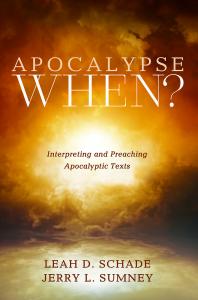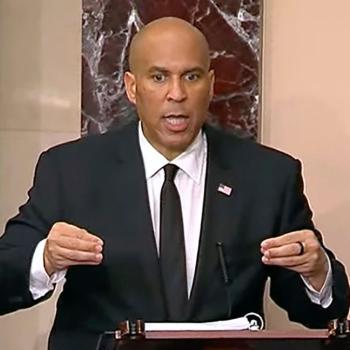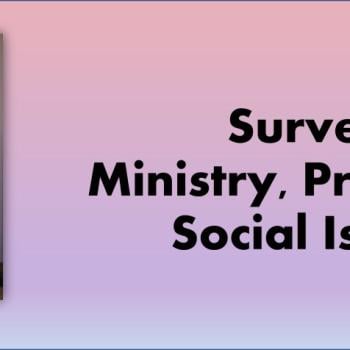What’s the point of Jesus giving dire warnings about the end-times in Mark 13:24-37? If it doesn’t mean building underground shelters stocked with canned peaches, or going into the woods with guns to train for taking out our enemies, what does it mean? What we learn—and what we must convey in our sermons—is that our focus is to live a life of faithful alertness.
This is an excerpt from my book co-authored with Jerry Sumney, Apocalypse When?: A Guide to Interpreting and Preaching Apocalyptic Texts (Cascade, 2020).

After laying out exegetical and homiletical principles in Chapters 1 and 2, each chapter is divided into three sections. The first section is an exegesis of a text by Sumney. The second and third sections are ideas for preaching and a sample sermon that I have written.
In this excerpt, I suggest ideas for preaching on Mark 13:24-37, the Gospel reading for the First Sunday in Advent, Year B, in the Revised Common Lectionary. In the next installment, I share a sermon that illustrates these principles in action: “Gathering Up the Fragments.”
Considering ministry context for Mark 13:24-37
But about that day or hour no one knows, neither the angels in heaven, nor the Son, but only the Father. Beware, keep alert; for you do not know when the time will come.’ (Mark 13:32-33)
In the verses prior to this pericope, Jesus describes a period of terrible suffering. So the preacher will want to ask, in what ways has the congregation and/or community experienced suffering? One of the most powerful things we can do as preachers is to name that suffering and then frame it within a biblical and theological context. In this way, those who have suffered will have the experience of being seen, being paid attention to, and being validated as worthy of God’s care.
By speaking forthrightly about suffering, the preacher can exercise what homiletician Dale Andrews called “prophetic care”—a way of understanding prophetic preaching as an expression of pastoral care. Andrews saw pastoral care and prophetic proclamation not as two contrasting aspects of ministry, but as complementary and reinforcing of each other. Caring for one’s congregation necessarily entails naming and calling out sin and suffering (including systemic sin) in a prophetic way. This prophetic voice, then, arises from a pastor’s deep and empathetic—even suffering—love for God’s people.
The preacher will also want to be attentive to social, national, and environmental contexts.
What are current events or environmental news that may feel as if “the powers in the heavens” are being shaken? Because of the nature of instantaneous newsfeeds from around the world, the barrage of headlines can make it seem as if the “stars are falling from heaven.” When natural disasters, wars, the effects of climate disruption, and health pandemics overwhelm us, sometimes biblical language found in passages such as Mark 13:24–37 is the only thing that captures the enormity of what we are experiencing.
This is why understanding the historical context of the passage can be especially helpful. Using Sumney’s exegesis, we learn that the original readers/hearers of Mark’s Gospel were experiencing existential angst with the destruction of the temple. In the sermon, the preacher will want to explore what we can learn from that period of time that can shed light on our own period of upheaval.
Countering apocalyptic panic
The temptation for some who read these texts in light current events is that they may latch onto them as portents of apocalyptic doom that can induce either paralyzing fear or susceptibility to those who profit from manipulating such fear. This manipulation may manifest in any number of ways, including obeisance to militant strongmen and authoritarianism, the stockpiling of guns and ammunition, or attacks on those scapegoated for the current state of desperation. Or one’s fear about end-times may manifest as an unhealthy obsession with apocalyptic fiction and conspiracy theories.

In any case, solid exegesis of Mark 13:24-37 can help counter alarmism and provide a remedying dose of historical context. What we learn from Sumney’s exegesis is that this text was not intended to stoke apocalyptic panic, but actually quell it by keeping a broader perspective on what is happening. Just as the Roman War in the first century was not a portent of the second coming of Jesus, neither are the calamitous events of our own time necessarily pointing to Jesus “coming in the clouds.”
Preaching faithful alertness
If we understand that “there are no events in world history one can point to as clear evidence that the End is near,” as Sumney notes in his exegesis (see Chapter 4, p. 53), what is the point of Jesus giving such dire warnings about the end-times? If it doesn’t mean building underground shelters stocked with canned peaches, or going into the woods with guns to train for taking out our enemies, what does it mean?
What we learn—and what we must convey in our sermons—is that a more important focus is to live a life of faithful alertness.
The preacher can develop this idea of faithful alertness by discussing the two parables in this passage about the fig tree and household keeping awake.
Just as Jesus points to the fig tree, an illustration from nature, the sermon can also draw on images from Creation to illustrate the ways in which nature conveys important information—if we only pay attention. Congregations whose members live close to the land, water, and other elements of nature will understand this intuitively. Those whose connections to nature are more tenuous, or who live in settings where they are not as exposed to the rhythms of nature, will need robust descriptions to help the images come alive. In either case, it’s worth noting that nature becomes Jesus’ teaching partner; likewise, preachers can draw on nature in their own sermons.
The preacher can also offer a contemporary illustration of the parable of the household servants awaiting their master’s return.
What are examples of expectant waiting in Mark 13:24-37 that will resonate with your congregation?
You might tell two contrasting stories—one of “falling asleep” and being caught unprepared; and one of “keeping awake,” alert to the signs of Jesus’ imminent return. In this way, the preacher might employ a more realized eschatology to help the congregation prepare for Christ’s appearance in the here-and-now, even as his ultimate arrival has not yet been fulfilled.
Read also:
Gathering Up the Fragments: A Sermon on Mark 13:24-37
Learning to Welcome the Dark: Advent 1
Rooted and Rising in Advent: 28 Days for Connecting with Earth
Jesus, Apocalyptic Discourse, and the Climate Crisis: Ideas for Preaching Matthew 24:36-44

Leah D. Schade is the Assistant Professor of Preaching and Worship at Lexington Theological Seminary in Kentucky and ordained in the ELCA. Dr. Schade does not speak for LTS or the ELCA; her opinions are her own. She is the author of Preaching in the Purple Zone: Ministry in the Red-Blue Divide (Rowman & Littlefield, 2019) and Creation-Crisis Preaching: Ecology, Theology, and the Pulpit (Chalice Press, 2015). She is the co-editor of Rooted and Rising: Voices of Courage in a Time of Climate Crisis (Rowman & Littlefield, 2019). Her latest book, co-written with Jerry Sumney is Apocalypse When?: A Guide to Interpreting and Preaching Apocalyptic Texts (Wipf & Stock, 2020).
Leah is also co-founder of the Clergy Emergency League, a grassroots network of clergy that provides support, accountability, resources, and networking for clergy to prophetically minister in their congregations and the public square in this time of political upheaval, social unrest, and partisan division.
Twitter: @LeahSchade
Facebook: https://www.facebook.com/LeahDSchade/













